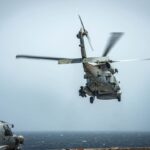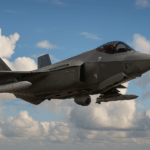June 20, 2025 – PARIS – Collaborative Combat Aircraft, or CCAs, stepped onto the world stage this week at the Paris Air Show. Two full-scale mock-ups – Anduril’s Fury YFQ-44 and General Atomics’ YFQ-42 – drew steady crowds. Executives from both firms stressed one message: Europe can help build the fleet, not just buy it. Defense officials confirm that Washington supports the idea, marking a sharp break from past export cycles that delayed foreign access for years.
CCAs are unmanned fighter-class jets built to fight beside crewed aircraft. The U.S. Air Force wants them to carry sensors, electronic-warfare pods, and weapons while costing a fraction of an F-35. That cost target – roughly a third of a fifth-generation fighter – explains why European air forces paid close attention. According to industry sources, Italy, Germany, Poland, and the Netherlands all requested private briefings during the show.
Anduril’s Fury YFQ-44 Demonstrates Modular European Assembly Potential
Anduril’s stand featured a full-size Fury with folded wings to show shipping options. A new deal with Rheinmetall lets the partners explore German final assembly, shared intellectual-property rights, and a split supply chain that taps small and medium enterprises across the European Union. Company engineers say Rheinmetall’s composite work on the F-35 enters Fury airframe production with only minor tooling changes. They also see potential to co-develop solid-rocket motors for the Barracuda cruise-missile family, using Rheinmetall’s existing propellant lines.
The partnership model uses three tracks. First, early U.S.-built airframes would ship to Germany for country-specific sensors and weapons. Second, a follow-on run could shift airframe builds to Rheinmetall’s Bremen campus to feed regional demand. Third, a “franchise” model would license blueprints to other EU primes once volume passes a still-undisclosed threshold. Anduril’s leadership argues that the plan gives European governments clear veto power over sensitive subsystems while also keeping program tempo high.
General Atomics presented a different roadmap. The firm wants to select one “lead integrator” able to host a pan-European line for the YFQ-42. Candidate companies include Avio Aero in Italy and GKN Aerospace in Sweden, though no agreement has been signed. Dave Alexander, the company’s president, told reporters that export licenses “could arrive within weeks, not months.” He placed the aircraft’s projected fly-away price “well under twenty million dollars,” an aggressive figure that caught the attention of several air-staff chiefs walking the halls. This contrasts with the planned upgrades to the F-35, which highlight rising costs and concerns about platform obsolescence.
Like Fury, the YFQ-42 uses an open avionics back-plane. Defense officials confirm that the design lets customers replace U.S. sensor suites with local payloads in less than a day of wiring work. Our analysis shows that such swap-out speed matters because many European air forces prize air-to-ground weapons over the U.S. Air Force’s initial air-to-air focus. General Atomics engineers demonstrated a digital mock-up that replaced the standard radar with a Franco-German electronic-attack pod and a Norwegian precision-strike missile – all inside the same internal bay.
U.S. Government Support Accelerates CCA Export and Co-Production
Air Force representatives staffed each booth and introduced foreign delegations to company teams. That level of encouragement rarely appears before a program’s first flight. The service plans a fly-off later this summer and intends to choose one or both designs for Increment 1 production by early 2026. Washington’s willingness to talk co-production today signals confidence that export security questions are manageable.
Affordability continues to drive the conversation. European program directors must stretch budgets already hit by ammunition back-orders and combat aircraft upgrades. General Atomics’ sub-$20 million claim sets a benchmark. Anduril did not release a figure but pointed to Fury’s automated molding process and re-usable tooling to imply similar savings. Both firms pitch CCAs as “affordable mass,” a term that resonates with planners who need numbers on the ramp, not just performance charts.
European Defense Policy Incentives Boost Local CCA Production
Policy tailwinds also matter. Brussels unveiled the Defence Readiness Omnibus on 17 June, cutting permit times to sixty days and instructing competition authorities to treat defense production as a strategic good. At the same time, EU finance ministers approved the €150 billion Security Action for Europe (SAFE) loan instrument. Those moves give member states fresh ways to pay for rapid procurement and reward programs that place work inside the union.
The European levers that favor local CCA builds:
- Defence Readiness Omnibus – Slashes red-tape on defense permits and harmonizes rules across borders.
- SAFE instrument – Offers low-interest loans for joint procurement with a 65 percent EU content floor.
- ReArm Europe / Readiness 2030 plan – Encourages bulk contracts for drones, missiles, and munitions.
Industry strategists see CCAs fitting those policy slots. Local final assembly ticks the content box, and modular mission-kits let each nation show sovereign technology on board. A Polish version might carry a domestically built jammer; an Italian airframe could host a homegrown targeting pod.
Competition is already heating up. Boeing briefed European delegations on the MQ-28 Ghost Bat and hinted at U.K. assembly if orders follow. Saab and Airbus pushed their remote-carrier concepts under the Future Combat Air System umbrella. Yet the U.S. duo arrives with working hardware, U.S. funding, and momentum from the Air Force selection announced last year. This push for wingman aircraft options, including the MQ-28 Ghost Bat, brings new prospects for both collaborative combat and independent operations in future air combat scenarios.
Rapid Flight-Test Milestones and European Certification Plans
Anduril plans first flight from Edwards AFB in late July, with design-to-fly timing of only eighteen months. General Atomics aims for August at its Gray Butte site. Both companies built entire subsystems – fuel, environmental control, landing gear – to commercial standards so that European regulators can certify them without bespoke processes.
Mission Flexibility Enabled by Modular Payload Swapping
European wage scales, currency swings, and fragmented export policies can erode savings. Industry sources acknowledge that tooling duplication might raise non-recurring costs by ten percent. However, they argue that unit-price stability, supply-chain resilience, and political goodwill more than offset that premium.
Possible European CCA mission sets include:
- Stand-off jamming against integrated air defenses
- Autonomous suppression of enemy air defenses with anti-radiation missiles
- Hard-kill strike on mobile armored columns
- Airborne early-warning picket duty ahead of manned patrols
Each mission uses the same basic airframe. Swapping payloads involves removing four bolts and updating software, according to company technicians.
Long-Term Sustainment with Regional Depot-Level Maintenance
Long-term sustainment plans favor local depots. Rheinmetall proposes a two-tier model: core depot-level overhaul in Germany and lighter checks at national bases. General Atomics backs a similar framework run by the eventual lead integrator. That structure keeps cycle times low and pushes skilled jobs into regional hubs.
Our analysis shows that the co-production push reflects a broader shift in transatlantic defense trade. Instead of a one-way export, companies now offer shared design authority, data rights, and upgrade paths. European officials welcome that approach because it ensures that future modifications – new sensors, new weapons, even new engines – can happen without flying prototypes back across the Atlantic.
As the show closes, the picture is clear. CCAs are no longer just a U.S. experiment; they are an emerging market where European industry can claim a stake. Early access to design data, combined with EU finance tools, positions member states to field large numbers of intelligent wingmen before the decade ends. Practical details – export licenses, work-share ratios, and final pricing – remain to be hammered out, yet both vendors left Paris with full dance cards and a mandate to return with concrete production blueprints.
From here, the next decisive moments arrive in three waves: flight tests this summer, U.S. down-select early next year, and initial export license approvals soon after. If timelines hold, European co-production lines could cut metal by 2027. For air forces seeking cost-effective firepower and for governments seeking industrial dividends, CCAs now look less like a concept and more like a contract waiting for signatures.
REFERENCE SOURCES
- https://consilium.europa.eu/en/press/press-releases/2025/05/27/safe-council-adopts-150-billion-boost-for-joint-procurement-on-european-security-and-defence/
- https://www.reuters.com/business/aerospace-defense/drone-makers-battle-air-dominance-with-wingman-aircraft-2025-06-19/
- https://www.defenseone.com/business/2025/06/ccas-make-international-debut-companies-pitch-european-co-production/406208/
- https://breakingdefense.com/2025/06/at-first-paris-air-show-visit-anduril-inks-new-partnership-with-rheinmetall-on-drones-weapons/
- https://breakingdefense.com/2025/06/general-atomics-eyes-european-market-coproduction-for-cca/
- https://www.reuters.com/sustainability/boards-policy-regulation/eu-commission-proposes-reducing-red-tape-defence-industry-2025-06-17/
- https://www.airforce-technology.com/projects/collaborative-combat-aircraft-cca-usa/
- https://www.af.mil/News/Article-Display/Article/4092641/air-force-designates-two-mission-design-series-for-collaborative-combat-aircraft/


